The Wallabies set-piece defence has been developing with multiple midfield combinations by Dave Rennie and his staff in 2021, as they search for a back line to settle on.
After trying Matt To’omua, Hunter Paisami, Len Ikitau and Samu Kerevi over the Bledisloe series, they seem to have found a winning formula. In the last two tests against the Springboks, young Brumby Ikitau has performed well at outside centre anchoring their edge defence outside the recently returned Kerevi.
Ikitau, who scored two crucial tries in the second win over South Africa, has been a reliable and underrated piece of the puzzle for Rennie. While his stats on the surface don’t suggest much, averaging between three to four tackles a game, his defence has been vital for Australia.
The Wallabies have uncovered a genuine international centre prospect who has performed at an extremely high level over the last month. In contact he has been incredibly strong, going toe-to-toe with Springboks loose forwards, while showcasing an ability to also hold his own over the ball and contest and win turnovers at the breakdown.
Most importantly, it has been his disciplined reads and pinpoint execution of the Wallabies defensive system that has enabled his side to withstand and absorb pressure, leading to momentum-swinging moments.
Whilst the Springboks have made famous a high pressure, outside-in rush defence system, the Wallabies play a ‘whip’ type drift defence in most midfield zones, where the backs close down one-by-one like the motion of a cracking whip.
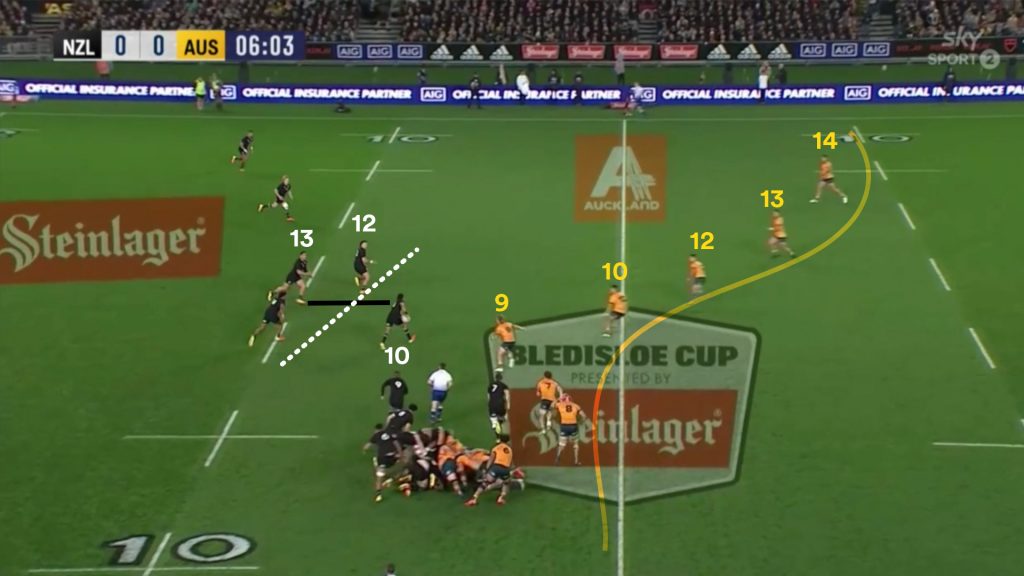
The Wallabies want to push the opposition over the sideline playing a mix of jockey defence to shepherd the ball to the outside, chasing play from the inside with an overall strategic goal of containment. They will bend, but not break.
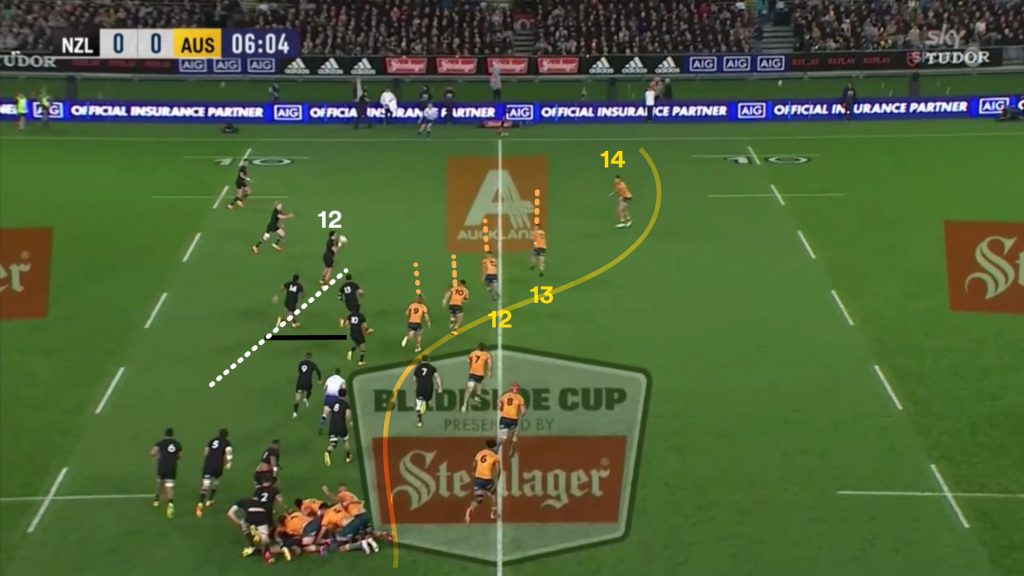
The result means there is plenty of outside space for the attacking side to use as the Wallabies backs sit back on their heels and wait for the ball to go outside them. There is no pressure as the Wallabies are inviting the opposition to go wide, which the All Blacks tried at Eden Park in the first test.
Although the Wallabies are ultimately looking to contain the offence, if they execute the whip defence well they are able to generate turnovers, either by forcing play over the sideline or striking at isolated carriers who are too far downfield.
Central to this style of defence has been outside centre Len Ikitau (13) who has shown sound decision-making, patience, commendable recovery speed and provided wide spacial coverage.
On the All Blacks’ second wide set-piece play of the first test, we see Ikitau’s wide range of skills in motion, and how he makes solid reads during the play. The All Blacks use a splitter-type play to get David Havili (12) the ball out the back running into Ikitau’s channel.
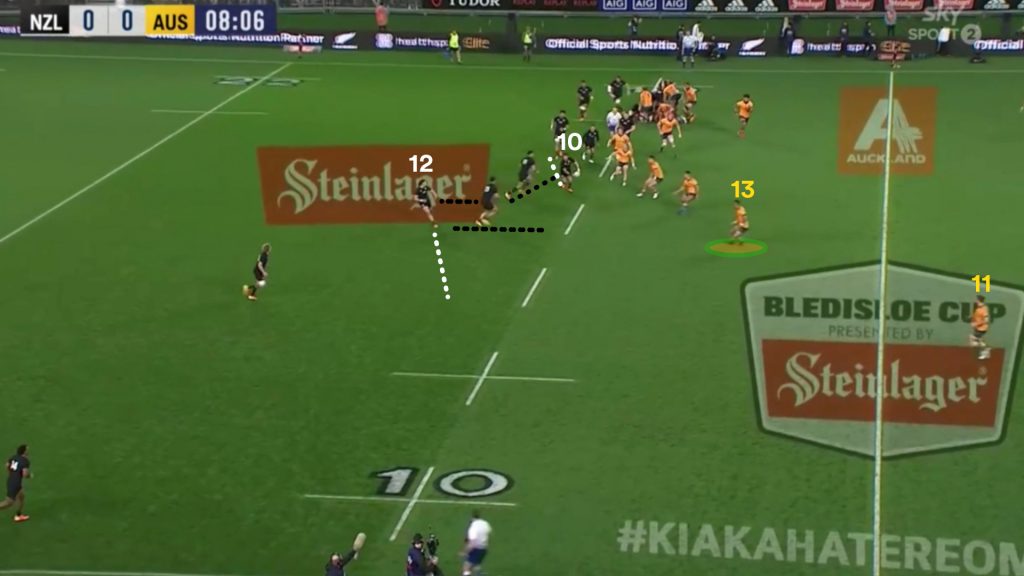
Once Havili has the ball, the All Blacks had a three-on-two overlap with the Wallabies disadvantaged and in recovery mode. With the traffic inside disrupting the Wallabies drifting inside support, Ikitau (13) cannot bounce out immediately to Damian McKenzie (15).
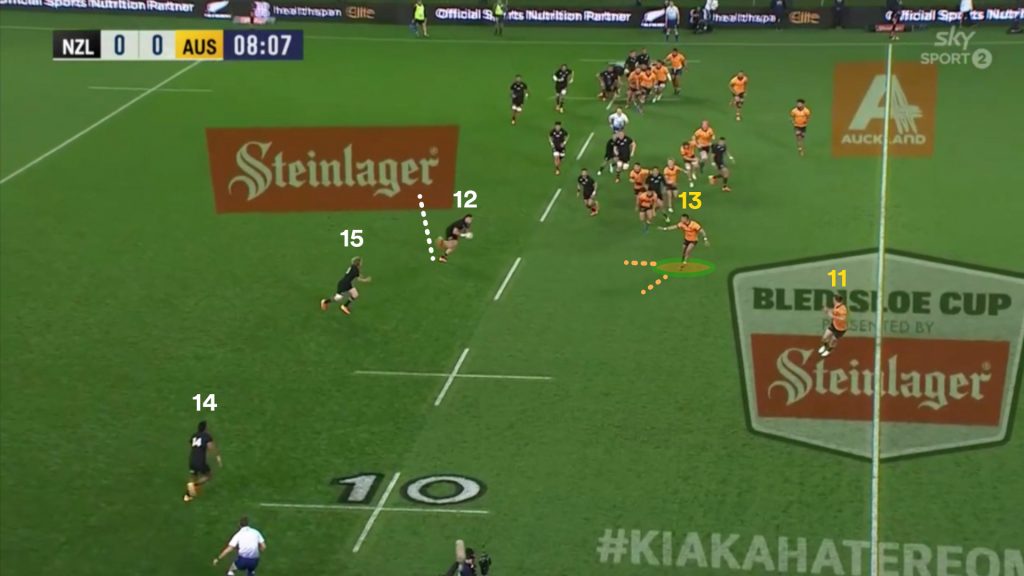
He has to wait patiently for Havili (12) to make a move before sliding in case the midfielder decided to run at his inside shoulder.
With the space on offer to the outside, Havili gives McKenzie early ball – which is exactly what the Wallabies wanted – allowing Ikitau to put the foot down and whittle down the situation to a much more manageable two-on-two.
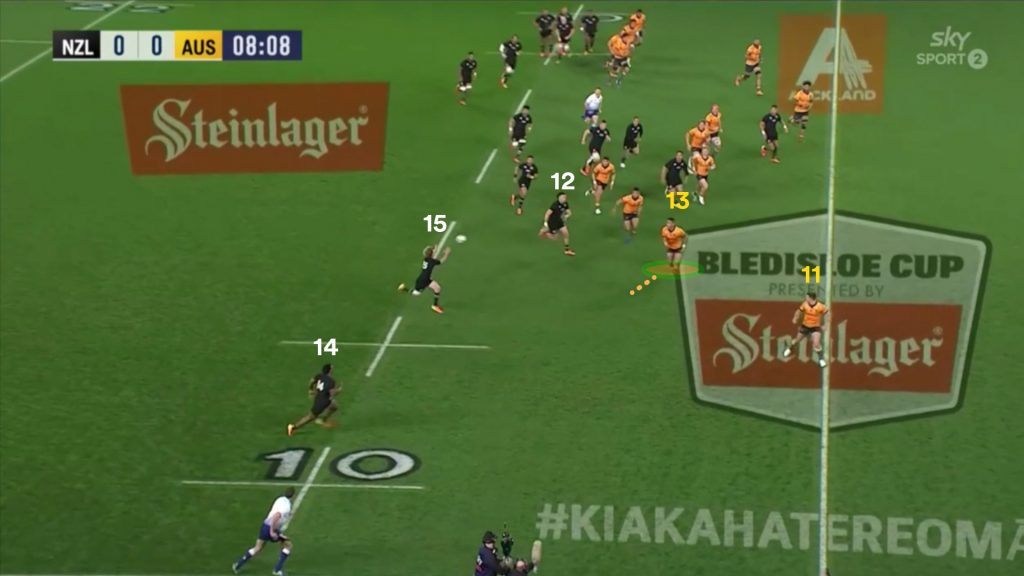
McKenzie does this same, offering early ball to Sevu Reece (14) and now the Wallabies edge defence have their final assignment and can close and force the All Blacks towards the sideline.
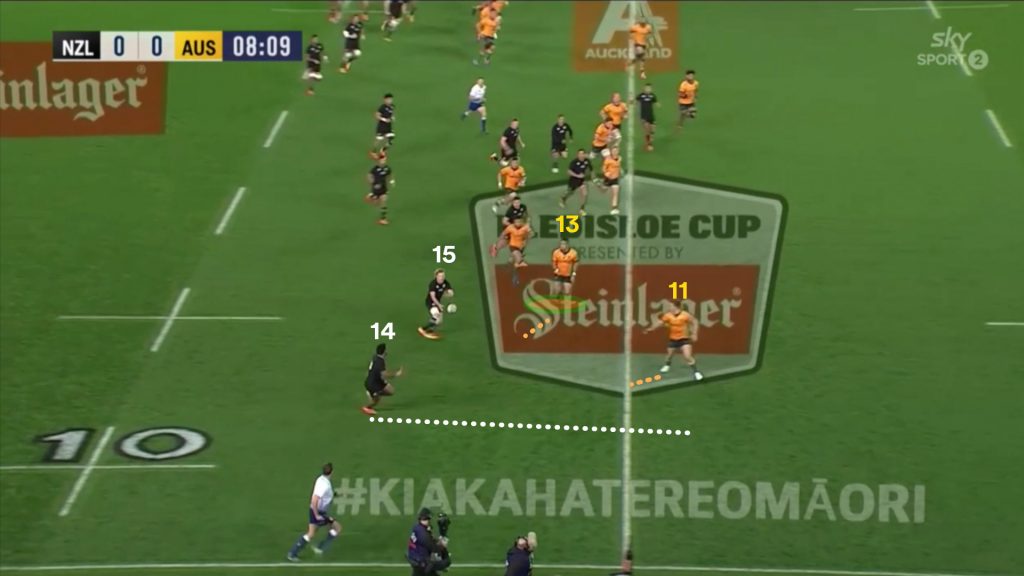

Andrew Kellaway (11) and Ikitau (13) complete a two-man tackle and force Reece over the sideline for a turnover, diffusing the situation. Although the All Blacks were making metres upfield, they failed to draw numbers into contact and the Wallabies were in complete control.
They were seduced by the space, gave early ball to the outside and then ultimately ran out of room as Ikitau played drift defence perfectly with discipline within his role. He worked across half the width of the field in jockey-mode to force that turnover and never let his concentration dip.
In Brisbane, the Springboks – who mainly take the direct approach with carries from inside centre Damian de Allende – were lured into playing the same way with width from set-piece platforms more than they usually do.
After the Gold Coast test, where they often kicked to the air on the first phase, played for set-piece penalties, or used De Allende in midfield zones, they saw the invitation and tried to take the Wallabies on in the outside channels with mixed results.
On the first midfield scrum, the Springboks try to go wide as De Allende (12) plays Pollard (10) out the back. The Wallabies stay patient again and wait for the play to move on the outside, anchored by Ikitau.

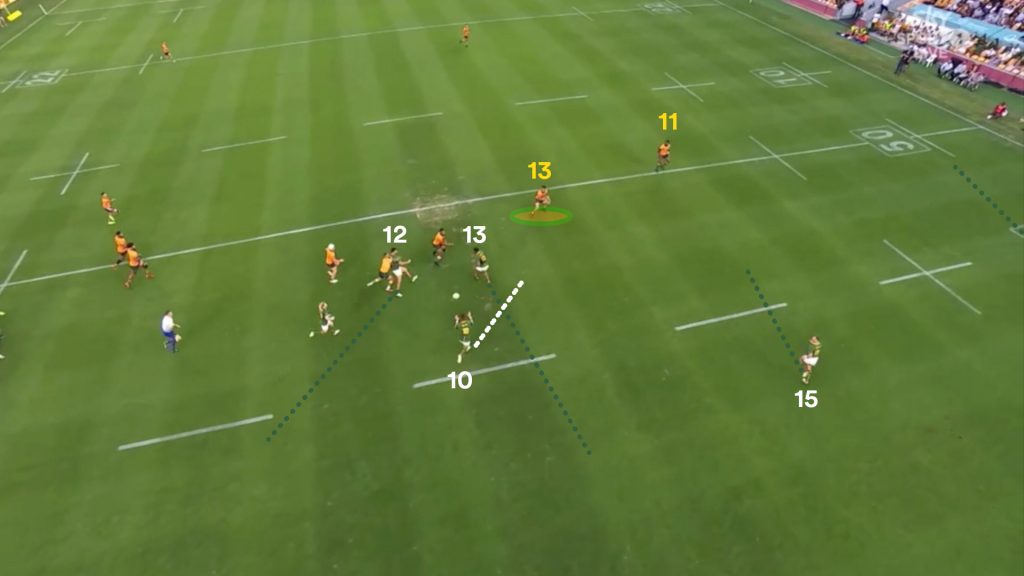
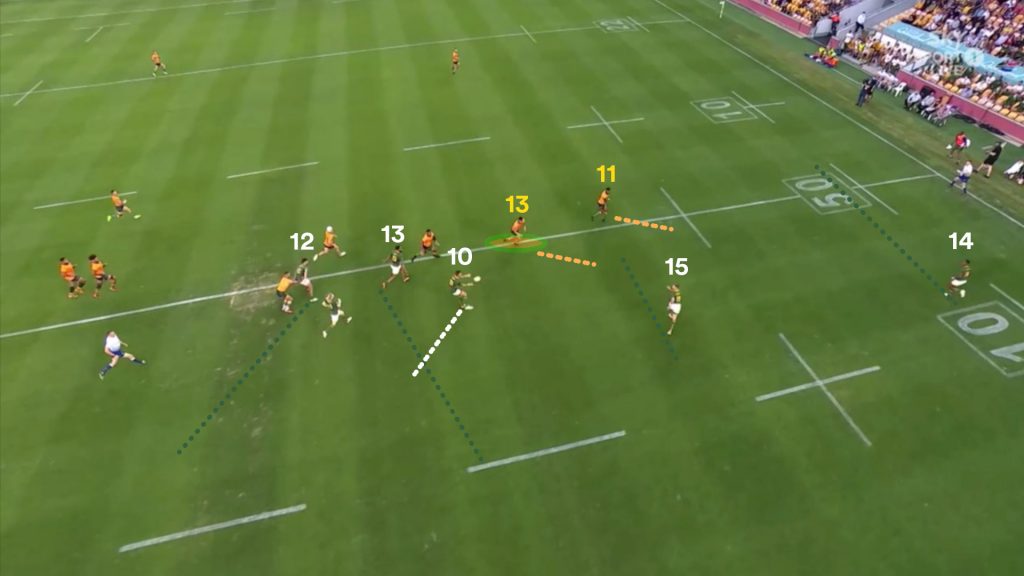
Both Handre Pollard and Willie le Roux (15) move the ball early without committing the defence, allowing Ikitau (13) and Koroibete (11) to close down the wide movement.
As the inside support under Koroibete, Ikitau has to protect his winger from Sbu Nkosi’s (14) right-foot step. The Springboks wing is a dangerous stepper, so it is Ikitau’s assignment once Nkosi steps back inside.
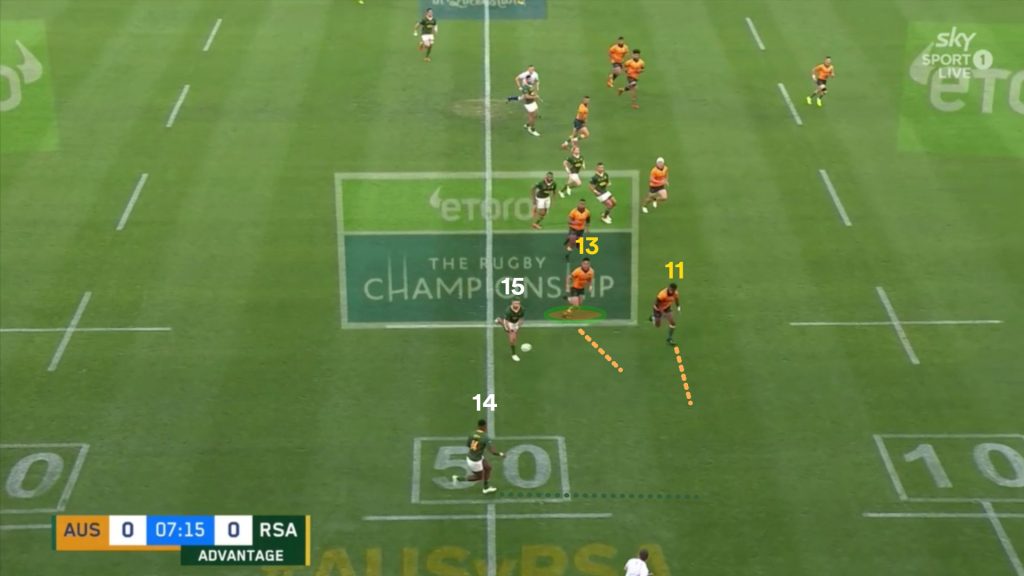
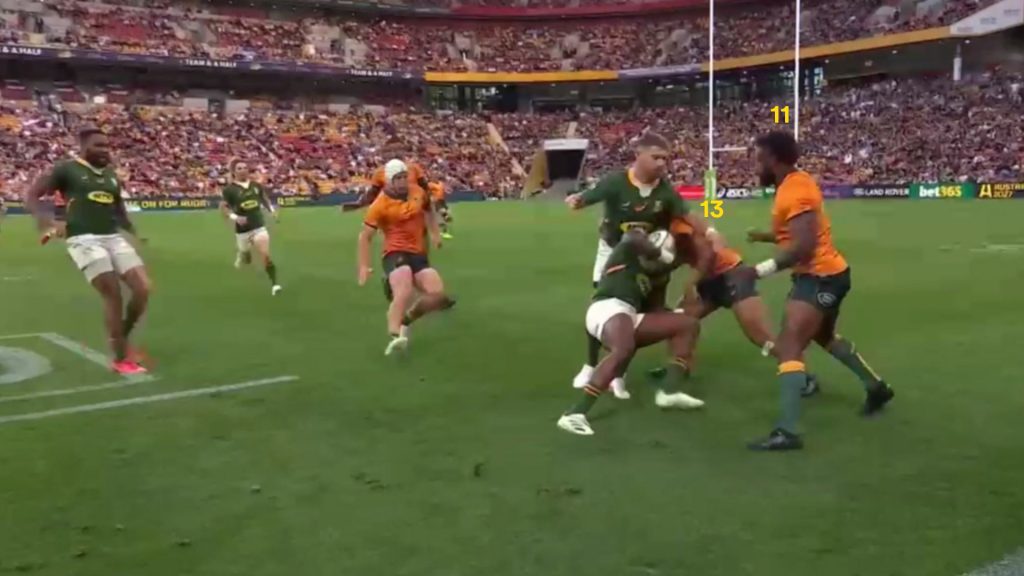
The Wallabies centre does his job despite some accidental obstruction from Le Roux. The Springboks had an advantage anyway, so play comes back otherwise a turnover was on offer again as the Springboks get tangled up.
On the next midfield set-piece, the Springboks use De Allende to carry on the first phase before looking for a quick release wide on the second phase. The Wallabies are caught very thin on the outside and Ikitau (13) has to cover multiple players.

Staying patient and disciplined, Ikitau waits for the assignment to become a two-on-two when Le Roux (15) receives the ball before attacking the ball carrier and closing in for the tackle.
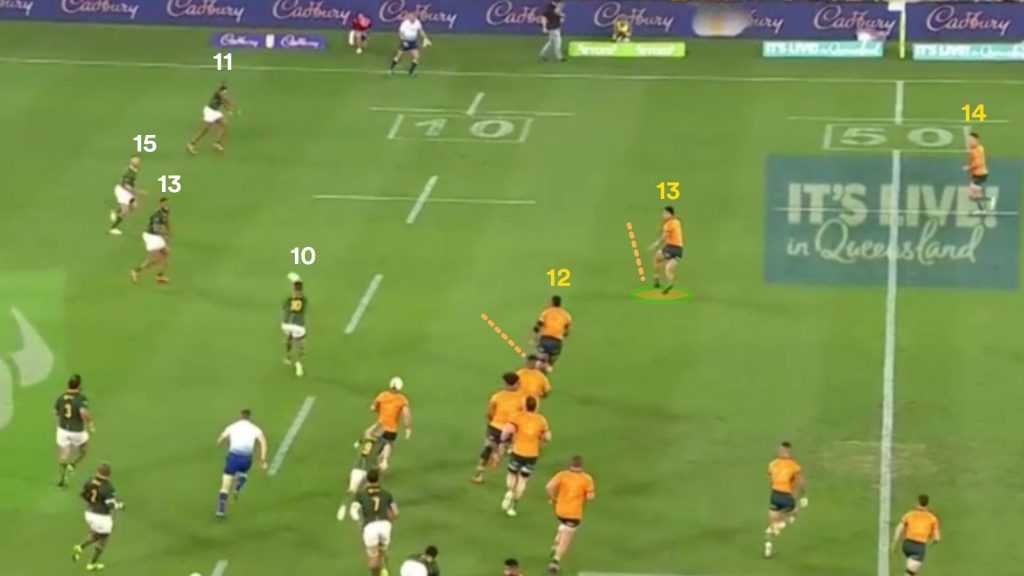
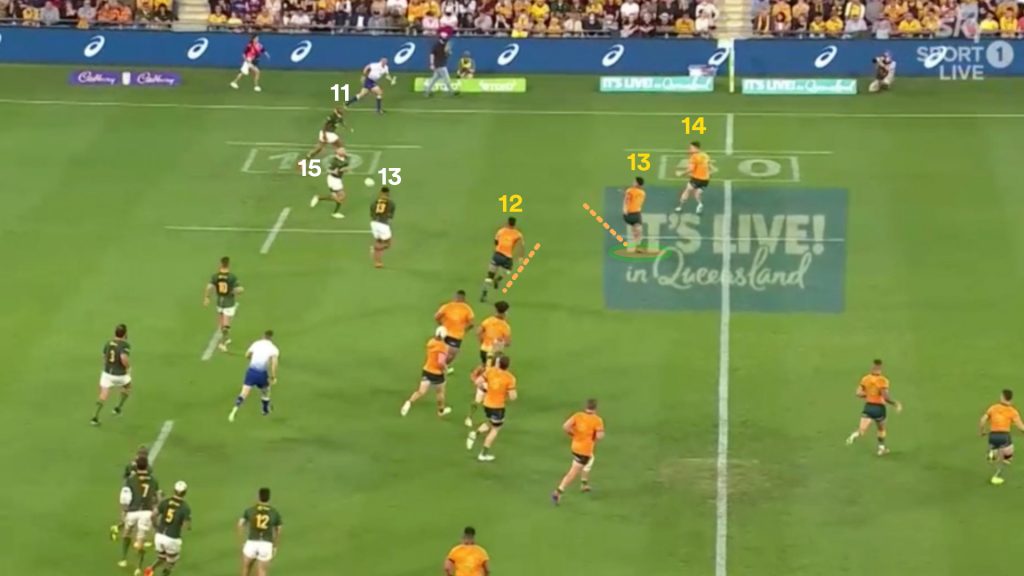
He chops Le Roux with a low tackle before getting back to his feet and contesting for the ball, putting pressure on the Springboks’ supporting players to get to the ruck and secure the possession.

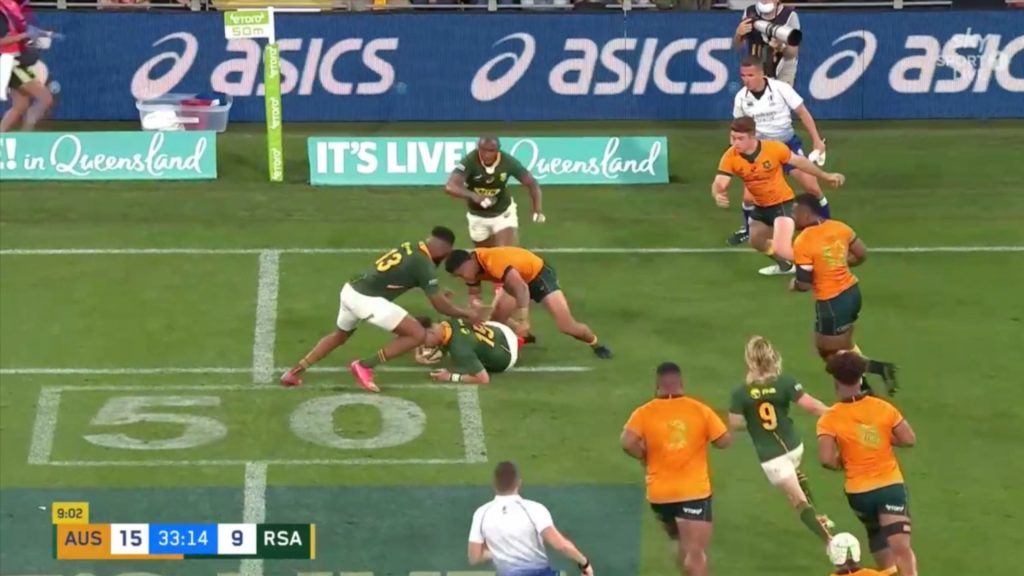
It was perfect execution of the Wallabies containment defence from Ikitau, with the midfielder preventing his side from conceding a line break from a disadvantaged position before flipping the script and applying the pressure back on the Springboks.
The Springboks were lured into going wide and shut down by the 22-year-old centre for the second time from the set-piece.
The Wallabies did not win turnovers from those two instances, but on the third wide play they came up with a critical steal on the last play of the half while holding a 15-12 lead. It was a critical moment in the game with the Springboks looking to draw or take the lead with the last play of the half.
The Springboks again used the same play with De Allende (12) playing Pollard (10) out behind the flat runner Lukhanyo Am (13).

As highlighted by EK Rugby Analysis on Twitter, the key man on this play ended up being Marika Koroibete (11) at the bottom of the screen tracking across from the scrum, but the sound defensive system keeps the Springboks from breaking the line.
The ball is pushed through to Makazole Mapimpi (11) and the Wallabies have the inside support to chase him down with Reece Hodge (22) closing from the backfield and Len Ikitau (13) tracking across.
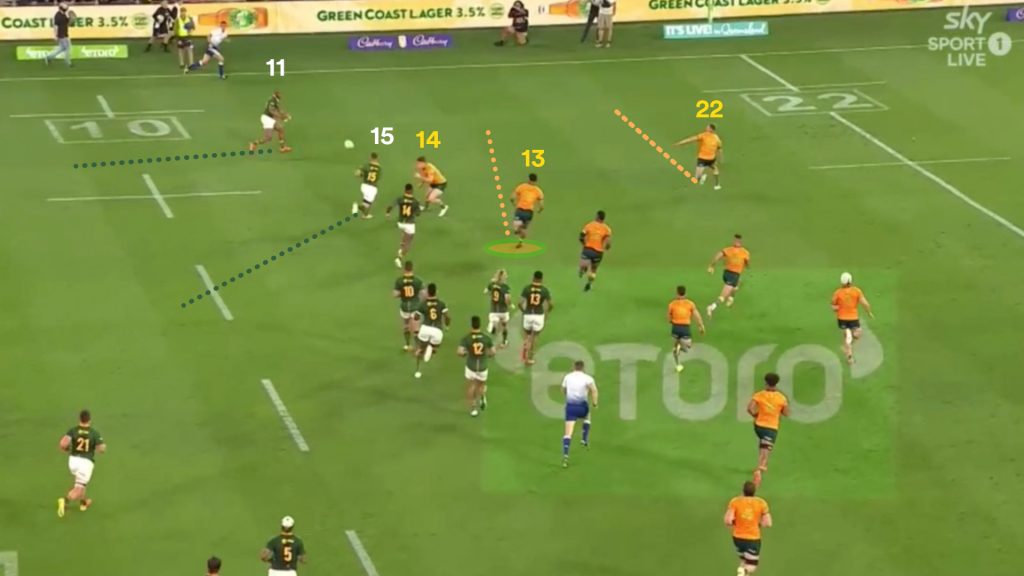
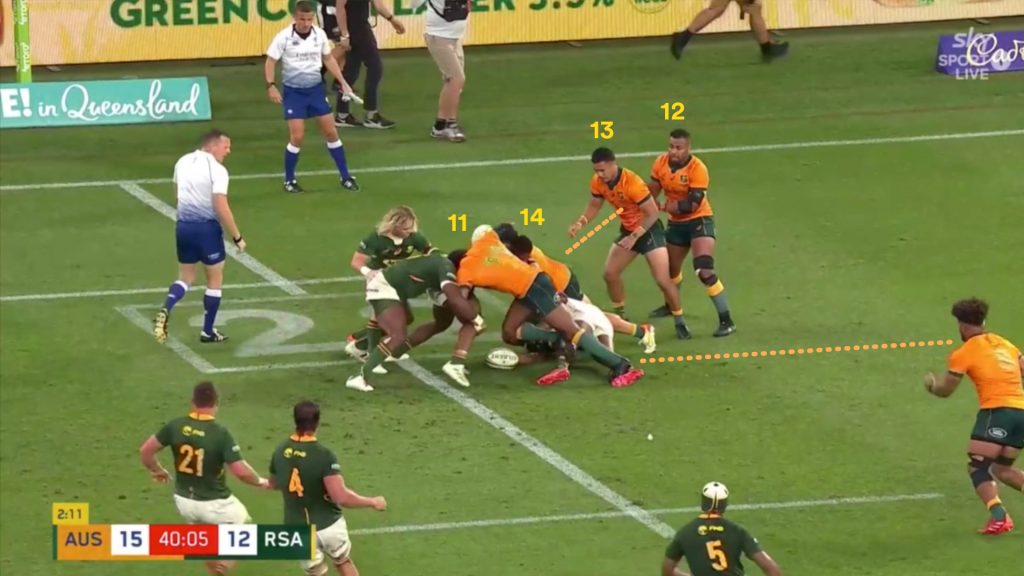
Tracking from the scrum on the opposite side of the field, Koroibete (11) entered the breakdown to counter ruck and the rest of the Wallabies close-by flood the ruck and push the Springboks off the ball on the isolated Mapimpi.
With time up on the clock, the Wallabies end the half by kicking the ball out after winning back possession. It was a huge defensive play by Koroibete in the context of the match, enabled by a disciplined and effective drift defence system.
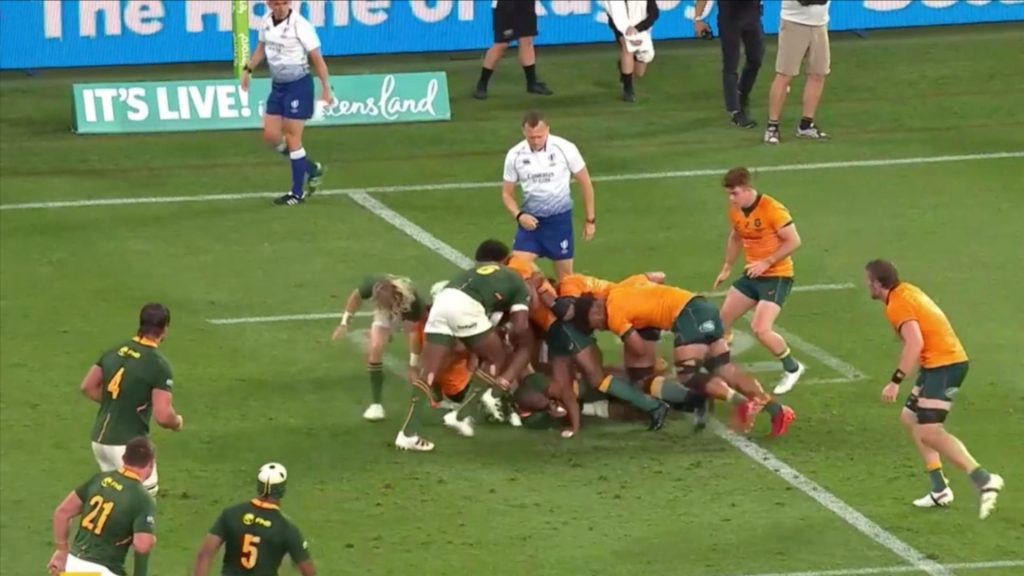
Ikitau continued making brilliant defensive plays in the second half. When the Springboks broke down the left-hand side following a regathered box kick, the midfielder was facing a three-on-one situation as Siya Kolisi burst on the outside of Michael Hooper.
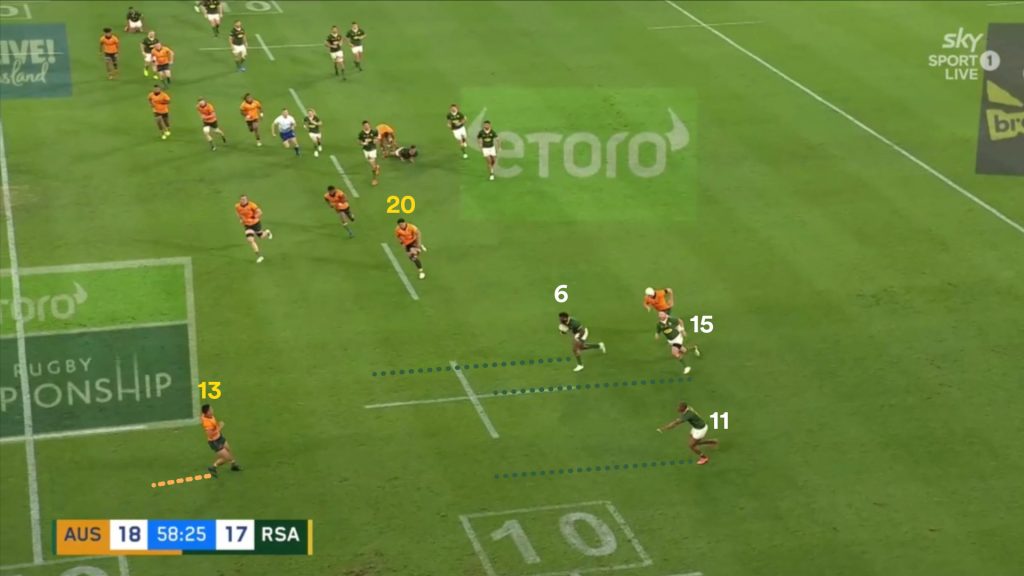
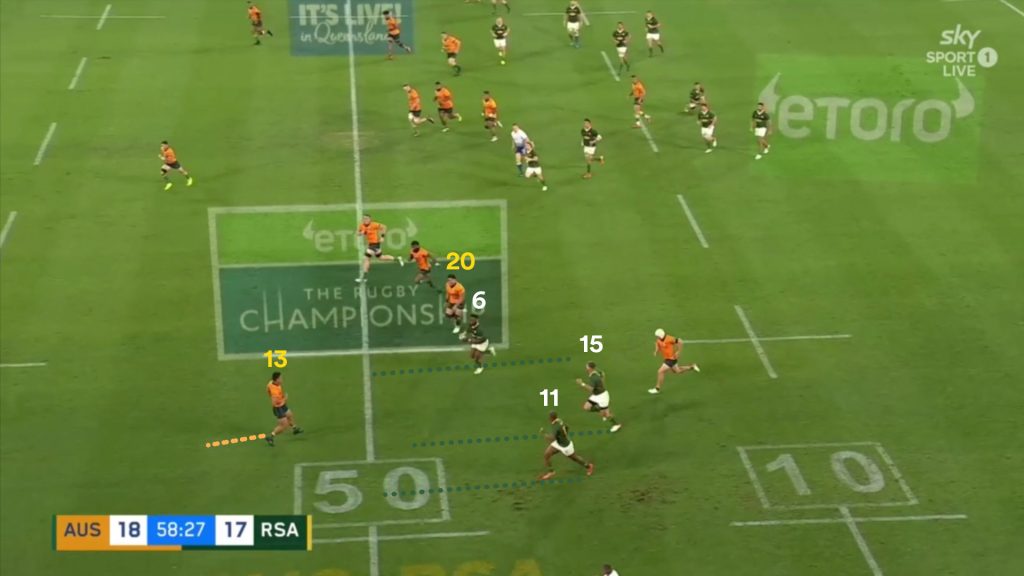
Ikitau immediately starts to backpedal like an NFL cornerback to buy time for the cover defence, unphased by the situation and calmly waiting for the attack to show their hand.
He covers Le Roux until the pass is made and then bundles Mapimpi (11) into touch, forcing the knock-on in the process in the ball-and-all tackle.
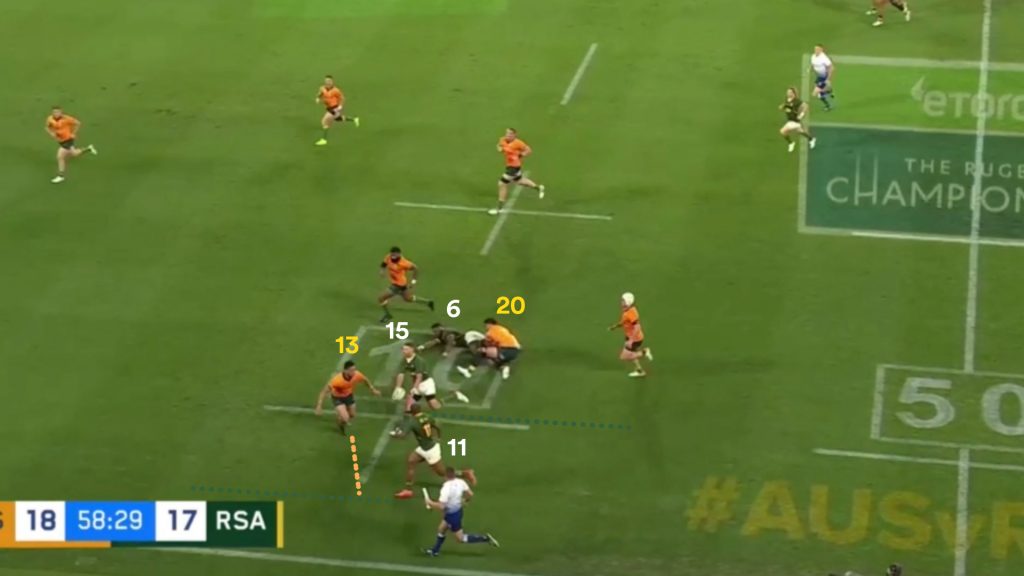
The high angle shot shows the brilliance of the save. This is an incredibly difficult movement to perform, requiring fast hip adjustments, a 360-degree range of running motion and multi-directional weight transfer combined with sound decision-making and timing.
The Springboks went wide within the first two phases four times and had zero line breaks and two turnovers, including the crucial one at the end of the first half. They played into the Wallabies’ hands after seeing space, ending with only frustration.
Heading into the two test matches, Springbok centre Lukhanyo Am was regarded as the world’s best centre. Remarkably, he has been completely outplayed in all facets by the 22-year-old Ikitau over the two tests.
Playing two different styles of defence, only one of the 13s has executed their role to a high level and come up with game-changing plays. Am’s form drop has been untimely for the Springboks, who need their star centre to be at the top of his game for their own defensive system to work.
But for the Wallabies, they have uncovered a genuine Test outside centre who at 22-years-old has plenty more upside ahead of him and could one day reach the level of Am. With an assured left boot, he gives them a wider kicking option as well which they have used so far from kickoff receipts.
In a position that is said to be the hardest in the game to defend from, Ikitau has taken to Test rugby like a duck to water with the defensive side of the game his strongest asset. His first try showed he can find some spark in attack as well.
The stats don’t show just how good he has been, particularly in Brisbane in the second win over the world champion Springboks. They have found a rock solid option to bring stability in outside channels, something that has been missing for quite some time.


Comments
Join free and tell us what you really think!
Sign up for free